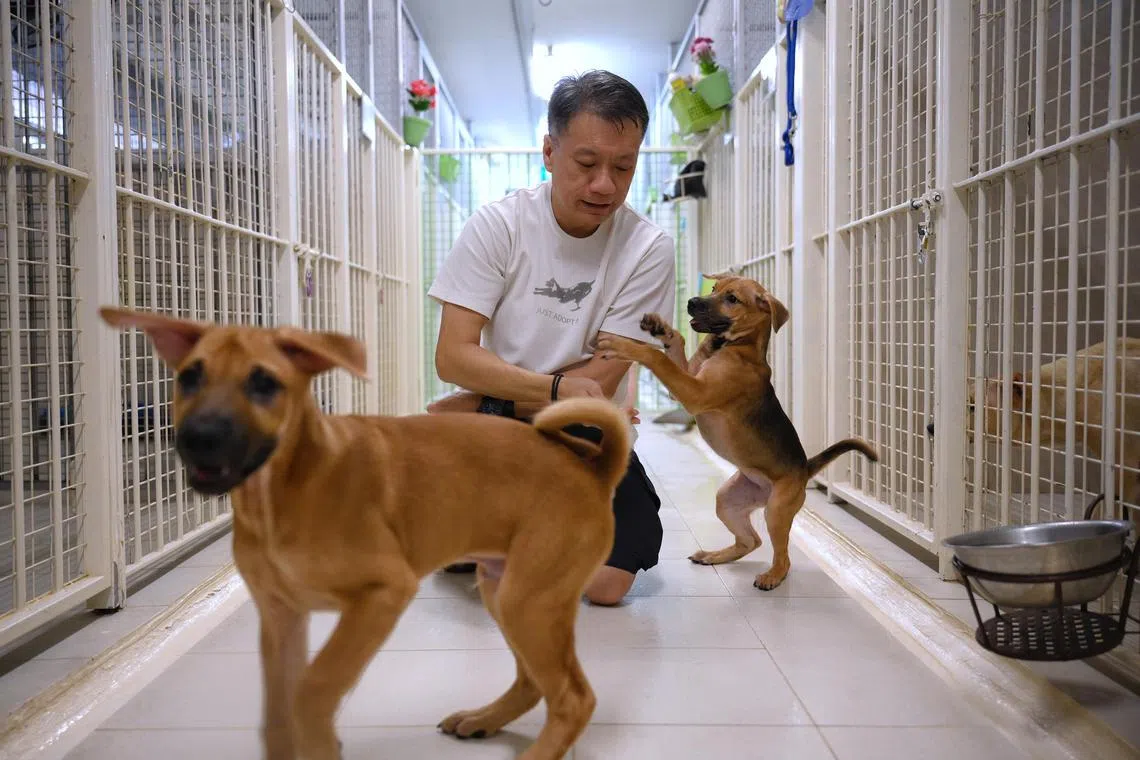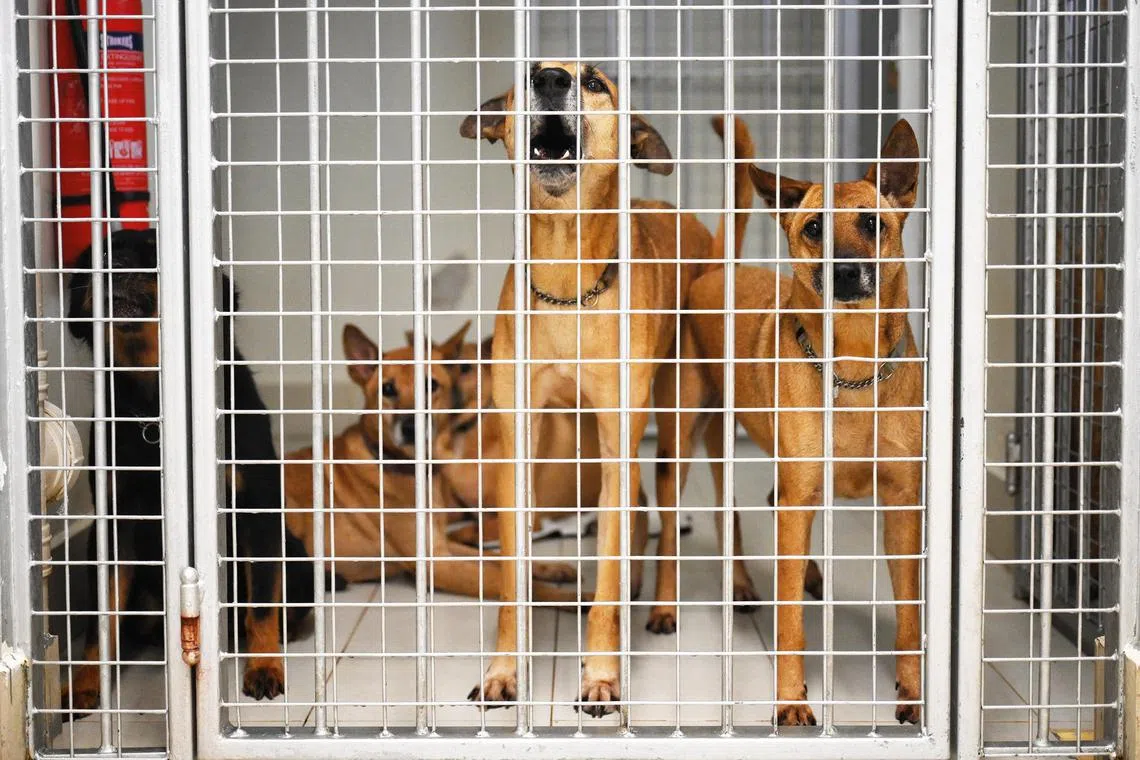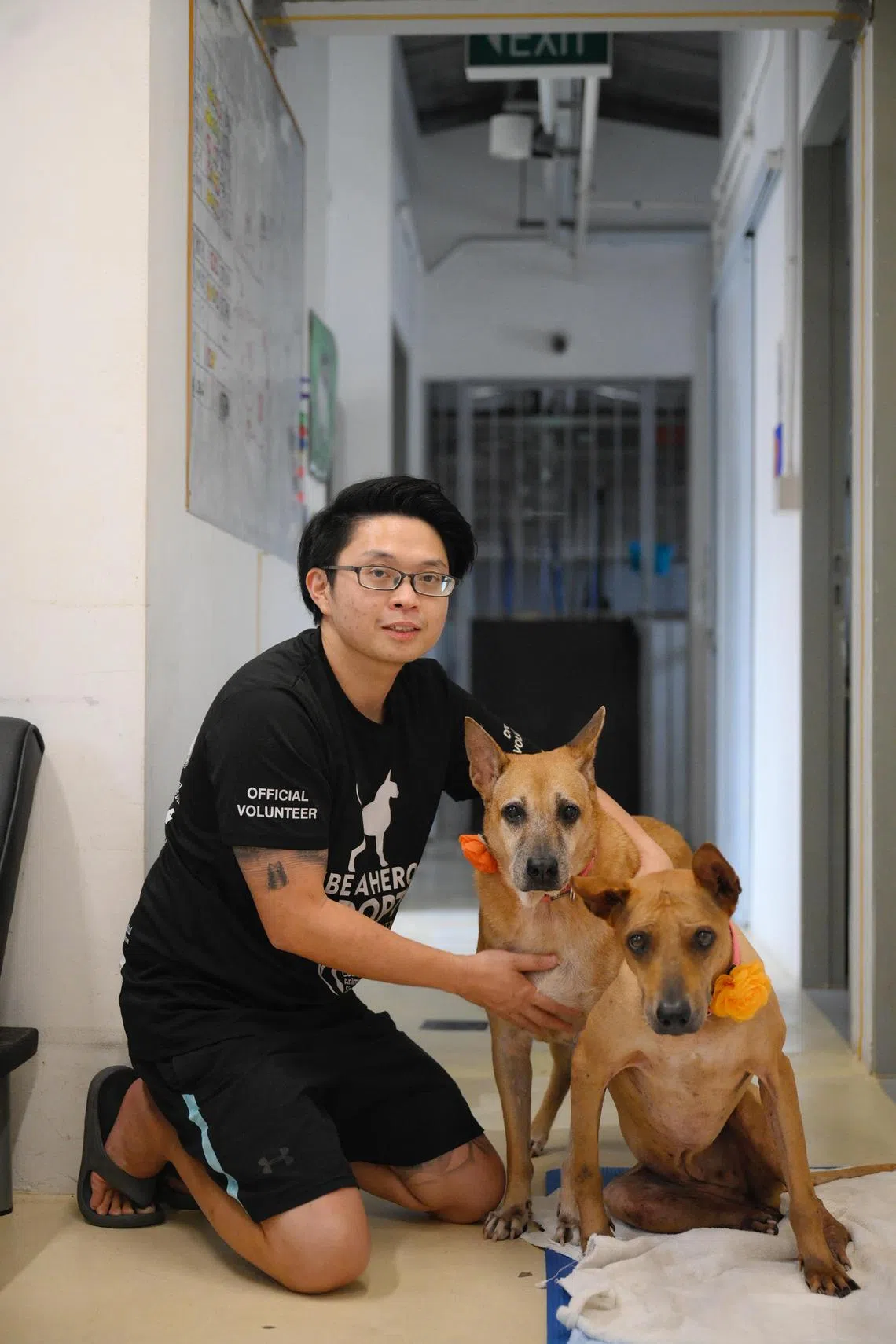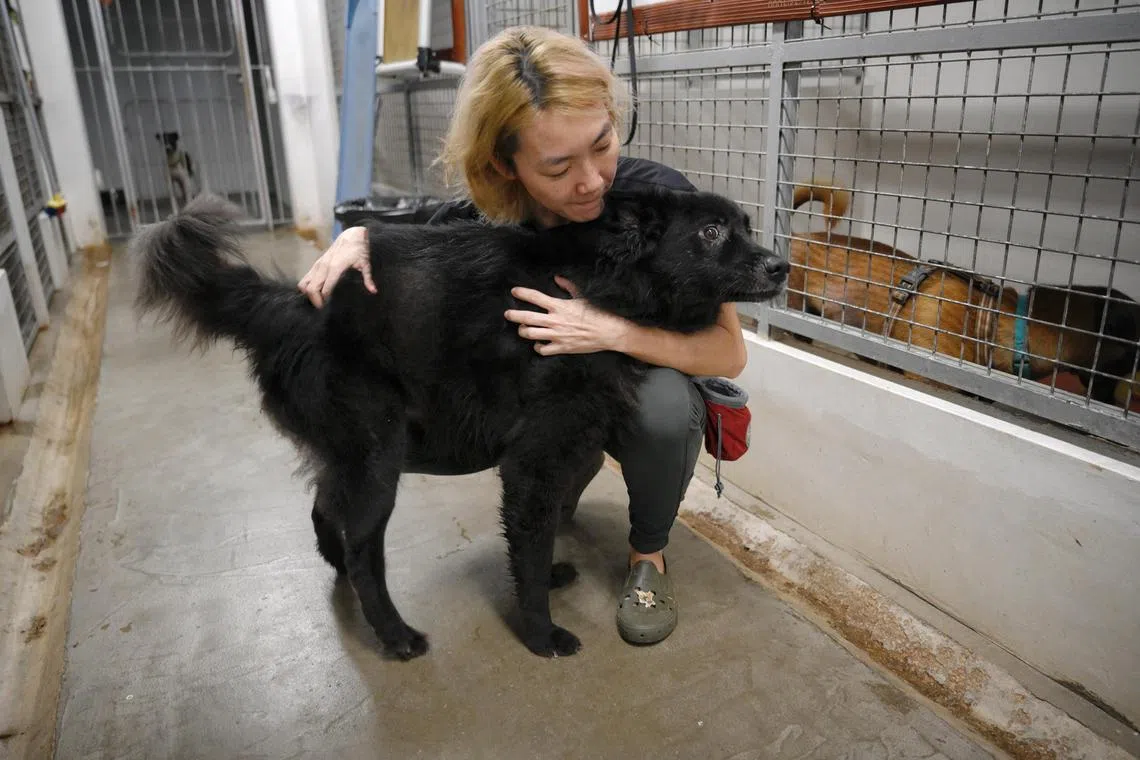No unified guidelines? Animal shelters chart their own paths on welfare standards
While animal shelters play a crucial role in caring for abandoned, lost or abused animals, they often face challenges ranging from operational management to financial constraints and falling adoption rates. Judith Tan looks at how they navigate the landscape without a unified set of guidelines.
Sign up now: Get ST's newsletters delivered to your inbox

Mr Ricky Yeo, founder of Action for Singapore Dogs, with puppies at the shelter.
ST PHOTO: MARK CHEONG
Follow topic:
- Singapore animal shelters operate with no unified guidelines, adapting standards from overseas organisations like the RSPCA.
- Shelters like ASD, CAS and SOSD limit animal intake and require veterinary checks to prevent overcrowding and disease, prioritising animal welfare.
- AVS is developing animal shelter guidelines after public consultation which took place between December 2024 and February 2025, and overseas study trips.
AI generated
SINGAPORE – With 90 dogs living in five units, each barely the size of a four-room Housing Board flat, Action for Singapore Dogs (ASD) is one of the bigger shelters at The Animal Lodge in Sungei Tengah.
But it cannot take in any more dogs.
“We limit the number of dogs we take in to about 90 so that there is no overcrowding,” said president and founder Ricky Yeo, 57.
“As dogs are social animals, we have also created community spaces for them by modifying the cages so that the separating fences can be opened, allowing for a much bigger space,” he told The Straits Times.
There are about 15 animal welfare groups operating shelters in Singapore. Twelve are at The Animal Lodge, which rents out space to shelters and businesses such as pet breeders and boarders.
The shelters, which are run as non-profit outfits, are either self-funded or supported by public donations.
Mr Yeo told ST that while the Animal and Veterinary Service (AVS) sets standards for animal enclosures, including those used in shelters, there are no unified or formalised guidelines on animal welfare in shelters in Singapore.
Such guidelines are in the works, with AVS now reviewing feedback from a two-month public consultation.
In the meantime, the shelters are largely left to their own devices.
“For ASD, we referred to the guidelines for design and management of animal shelters set out by the RSPCA and looked at the physiological, social, psychological, environmental and behavioural needs,” Mr Yeo said, referring to the Royal Society for the Prevention of Cruelty to Animals in Britain.

As dogs are social animals, the sides of the cages can be lifted to create bigger community spaces for them at the Action for Singapore Dogs shelter.
ST PHOTO: MARK CHEONG
With 25 years of caring for stray and abandoned dogs under its strict no-kill policy, ASD has made modifications to the shelter, which include the movable separating fences, bigger rooms to accommodate dogs that are nursing mothers, and better-designed rooms to reduce barking.
Causes for Animals Singapore (CAS) – another shelter at The Animal Lodge – also modelled its facility on standards adapted from those of overseas shelters.
Volunteer Marcus Tan, 39, said CAS built walkways along the sides of the cages – instead of between them – so that the dogs “do not get startled whenever a volunteer walks by”.

Mr Marcus Tan, a volunteer with Causes for Animals Singapore, with nine-year-old dogs Sandy (centre), which has immune-mediated polyarthritis, and Courtney, which has degenerative myelopathy.
ST PHOTO: MARK CHEONG
CAS limits its number of dogs at any one time to about 30, especially as its current shelter is smaller than its previous facility in Seletar.
It is a practical move, as the Tengah lodge has limited walking routes for shelter dogs, and the number of pet adoptions in Singapore has fallen.
Local animal shelters and welfare organisations have seen up to a 50 per cent fall in adoption numbers in the past few years.
Some attribute the drop to rising costs of living and more people returning to the office after the Covid-19 pandemic.
CAS now focuses on dogs that are older and need palliative care.
“We would like them to age with dignity,” Mr Tan said.
The shelters told ST that owners or rescuers who are handing pets to shelters should first take the pets to be examined by veterinarians, and the animals should be found healthy before being taken in by shelters. But often, the shelters end up doing it themselves.
Save Our Street Dogs (SOSD) noted that the shelters at The Animal Lodge are largely enclosed.
“We need the dogs and even cats to be healthy when they come in. Otherwise, an infectious disease can easily wipe them out,” said Ms Kieran Kua, 39, who heads operations at SOSD.
The shelter limits the number of its residents to 55.
“Prior to moving here, we had 110,” Ms Kua said.
All three shelters said most of their funds went to paying veterinary fees, which amounted to $482,000 in 2024 for ASD. The other two declined to give specific amounts.
AVS, a cluster under the National Parks Board, told ST that its team at The Animal Lodge regularly engages the shelters “to better support their efforts, including ensuring the well-being of animals under their care”.

Ms Kieran Kua, head of operations at Save Our Street Dogs, says there is a need to ensure that dogs coming into its shelter have a clean bill of health.
ST PHOTO: MARK CHEONG
While the shelters are “currently guided by their own internal standards and there is no stipulated cap on the number of animals at a shelter”, it said, “all animal shelters are responsible for the health and welfare of animals under their care”.
AVS reviews any feedback received on potential animal welfare issues at a facility and will work with the shelters to address them.
“Any suspected cases of failure in duty of care or animal cruelty will be investigated, and we will not hesitate to take appropriate enforcement action under the Animals and Birds Act if an offence is found to be committed,” it said.
The proposed guidelines on animal welfare are part of AVS’ efforts to raise the standards of pet-related industries.
The online public consultation from Dec 3, 2024, to Feb 2 received about 600 responses.
“Prior to this, we consulted our (animal welfare group) partners for preliminary views on the proposed guidelines in September 2024 – together with relevant stakeholders, including animal shelters, veterinarians and animal trainers – to suggest some of the proposed areas to be covered in the guide,” the AVS said.
ST understands that AVS also conducted several study trips to learn from its overseas counterparts, the most recent being to Brussels.
AVS declined to provide more information on these trips.
Mr Yeo said he hoped AVS would take into account its discussions with the shelters in issuing the guidelines.
He added: “As people who have been running shelters for the last 10, 20 years, we pay attention to designing the shelters for the animals’ needs and behaviours. We ensure the health and safety of our charges and are aware of the limitations we operate in.”


